traction control SATURN AURA HYBRID 2010 Owners Manual
[x] Cancel search | Manufacturer: SATURN, Model Year: 2010, Model line: AURA HYBRID, Model: SATURN AURA HYBRID 2010Pages: 400, PDF Size: 2.46 MB
Page 4 of 400
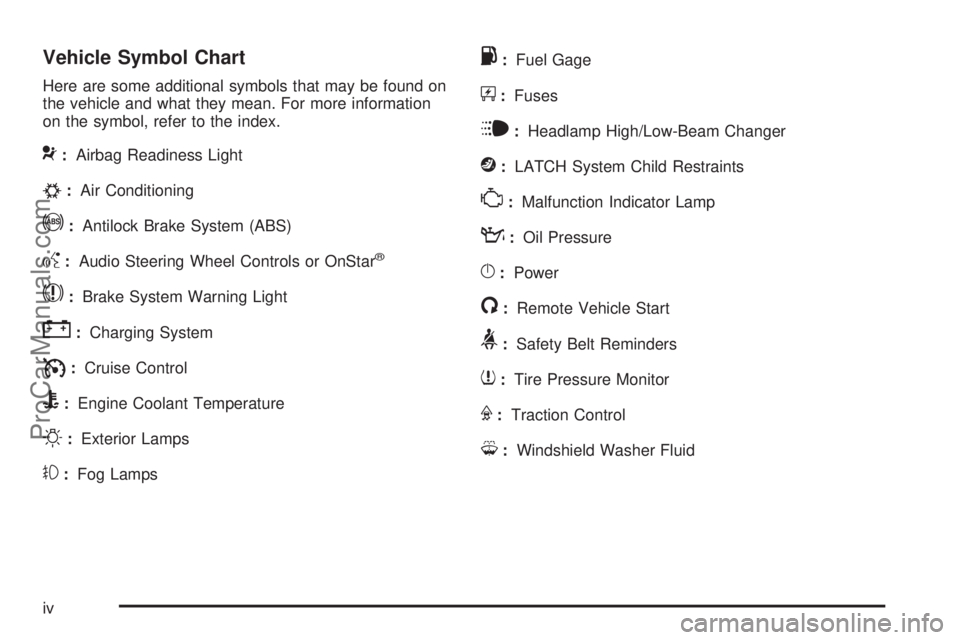
Vehicle Symbol Chart
Here are some additional symbols that may be found on
the vehicle and what they mean. For more information
on the symbol, refer to the index.
9:Airbag Readiness Light
#:Air Conditioning
!:Antilock Brake System (ABS)
g:Audio Steering Wheel Controls or OnStar®
$:Brake System Warning Light
":Charging System
I:Cruise Control
B:Engine Coolant Temperature
O:Exterior Lamps
#:Fog Lamps
.:Fuel Gage
+:Fuses
i:Headlamp High/Low-Beam Changer
j:LATCH System Child Restraints
*:Malfunction Indicator Lamp
::Oil Pressure
}:Power
/:Remote Vehicle Start
>:Safety Belt Reminders
7:Tire Pressure Monitor
F:Traction Control
M:Windshield Washer Fluid
iv
ProCarManuals.com
Page 5 of 400
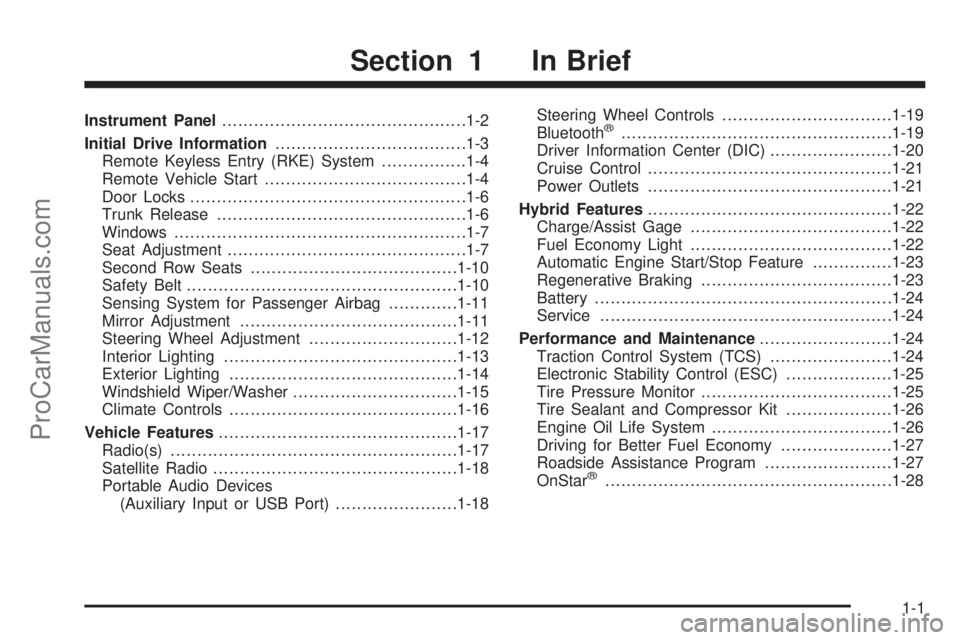
Instrument Panel..............................................1-2
Initial Drive Information....................................1-3
Remote Keyless Entry (RKE) System................1-4
Remote Vehicle Start......................................1-4
Door Locks....................................................1-6
Trunk Release...............................................1-6
Windows.......................................................1-7
Seat Adjustment.............................................1-7
Second Row Seats.......................................1-10
Safety Belt...................................................1-10
Sensing System for Passenger Airbag.............1-11
Mirror Adjustment.........................................1-11
Steering Wheel Adjustment............................1-12
Interior Lighting............................................1-13
Exterior Lighting...........................................1-14
Windshield Wiper/Washer...............................1-15
Climate Controls...........................................1-16
Vehicle Features.............................................1-17
Radio(s)......................................................1-17
Satellite Radio..............................................1-18
Portable Audio Devices
(Auxiliary Input or USB Port).......................1-18Steering Wheel Controls................................1-19
Bluetooth®...................................................1-19
Driver Information Center (DIC).......................1-20
Cruise Control..............................................1-21
Power Outlets..............................................1-21
Hybrid Features..............................................1-22
Charge/Assist Gage......................................1-22
Fuel Economy Light......................................1-22
Automatic Engine Start/Stop Feature...............1-23
Regenerative Braking....................................1-23
Battery........................................................1-24
Service.......................................................1-24
Performance and Maintenance.........................1-24
Traction Control System (TCS).......................1-24
Electronic Stability Control (ESC)....................1-25
Tire Pressure Monitor....................................1-25
Tire Sealant and Compressor Kit....................1-26
Engine Oil Life System..................................1-26
Driving for Better Fuel Economy.....................1-27
Roadside Assistance Program........................1-27
OnStar
®......................................................1-28
Section 1 In Brief
1-1
ProCarManuals.com
Page 7 of 400
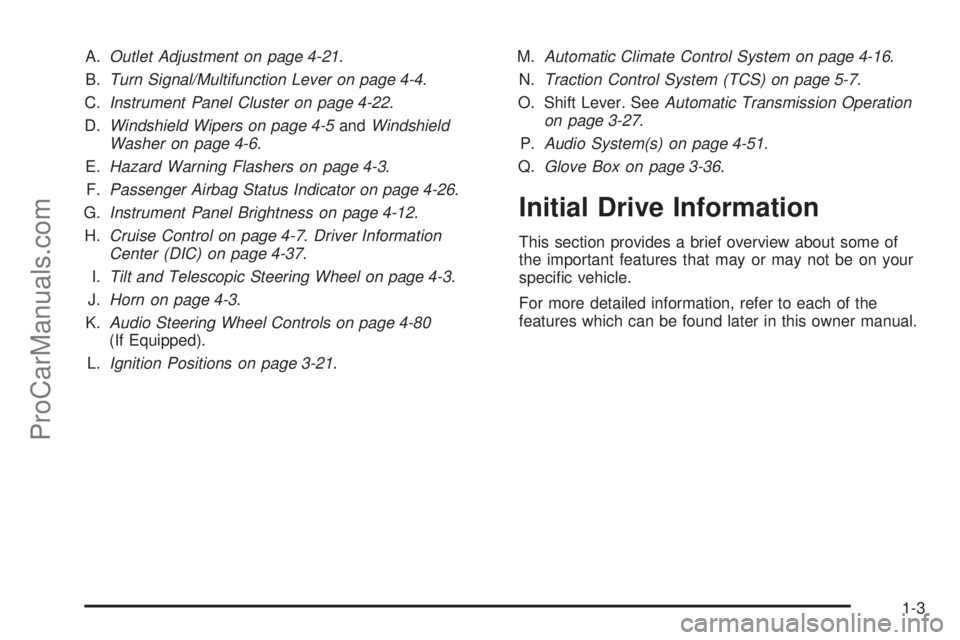
A.Outlet Adjustment on page 4-21.
B.Turn Signal/Multifunction Lever on page 4-4.
C.Instrument Panel Cluster on page 4-22.
D.Windshield Wipers on page 4-5andWindshield
Washer on page 4-6.
E.Hazard Warning Flashers on page 4-3.
F.Passenger Airbag Status Indicator on page 4-26.
G.Instrument Panel Brightness on page 4-12.
H.Cruise Control on page 4-7.Driver Information
Center (DIC) on page 4-37.
I.Tilt and Telescopic Steering Wheel on page 4-3.
J.Horn on page 4-3.
K.Audio Steering Wheel Controls on page 4-80
(If Equipped).
L.Ignition Positions on page 3-21.M.Automatic Climate Control System on page 4-16.
N.Traction Control System (TCS) on page 5-7.
O. Shift Lever. SeeAutomatic Transmission Operation
on page 3-27.
P.Audio System(s) on page 4-51.
Q.Glove Box on page 3-36.
Initial Drive Information
This section provides a brief overview about some of
the important features that may or may not be on your
specific vehicle.
For more detailed information, refer to each of the
features which can be found later in this owner manual.
1-3
ProCarManuals.com
Page 28 of 400

Battery
This vehicle has a standard 12-volt battery and a 36-volt
hybrid battery system.
The 36-volt battery is located behind the rear seat, in
the trunk. If the vehicle is to be stored for an extended
period of time, it should be driven at least every two
months or the 36-volt hybrid battery can be permanently
damaged. If a new 36-volt hybrid battery system is
needed, see your dealer/retailer. For important
information about the 36-volt hybrid battery, seeBattery
on page 6-34.
Service
Never try to do your own service on hybrid components.
You can be injured and the vehicle can be damaged
if you try to do your own service work. Service and
repair of these hybrid components should only be
performed by a trained service technician with the
proper knowledge and tools. SeeDoing Your Own
Service Work on page 6-4
Performance and Maintenance
Traction Control System (TCS)
The traction control system limits wheel spin. The
system turns on automatically every time the vehicle is
started.
•To turn off traction control, press and releaseton
the vertical surface in front of the center console
armrest.
Filluminates and the appropriate DIC
message displays. SeeDIC Warnings and
Messages on page 4-41.
•Press and release the button again to turn on
traction control.
For more information, seeTraction Control System
(TCS) on page 5-7.
1-24
ProCarManuals.com
Page 29 of 400
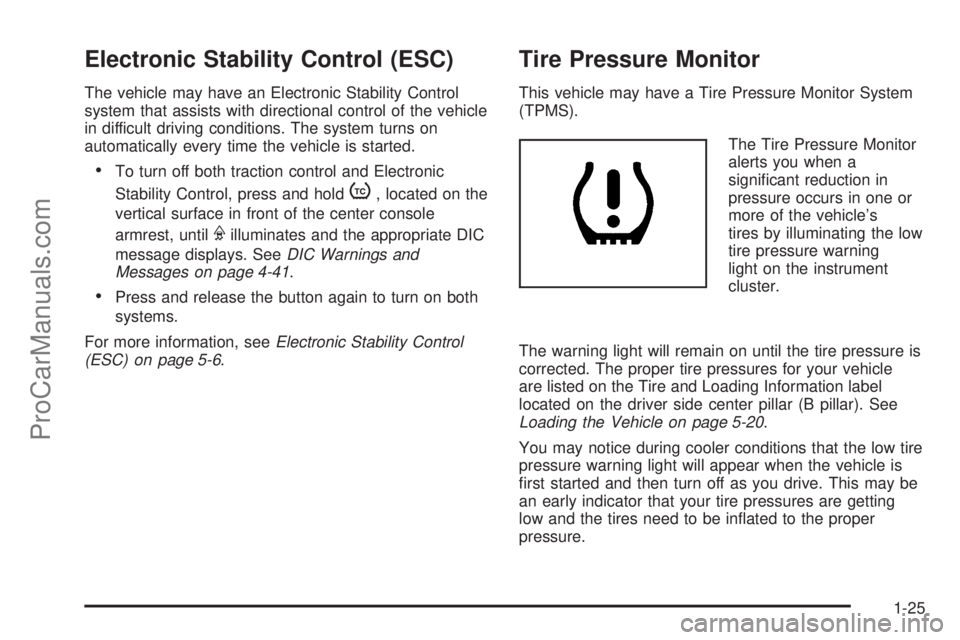
Electronic Stability Control (ESC)
The vehicle may have an Electronic Stability Control
system that assists with directional control of the vehicle
in difficult driving conditions. The system turns on
automatically every time the vehicle is started.
•To turn off both traction control and Electronic
Stability Control, press and hold
t, located on the
vertical surface in front of the center console
armrest, until
Filluminates and the appropriate DIC
message displays. SeeDIC Warnings and
Messages on page 4-41.
•Press and release the button again to turn on both
systems.
For more information, seeElectronic Stability Control
(ESC) on page 5-6.
Tire Pressure Monitor
This vehicle may have a Tire Pressure Monitor System
(TPMS).
The Tire Pressure Monitor
alerts you when a
significant reduction in
pressure occurs in one or
more of the vehicle’s
tires by illuminating the low
tire pressure warning
light on the instrument
cluster.
The warning light will remain on until the tire pressure is
corrected. The proper tire pressures for your vehicle
are listed on the Tire and Loading Information label
located on the driver side center pillar (B pillar). See
Loading the Vehicle on page 5-20.
You may notice during cooler conditions that the low tire
pressure warning light will appear when the vehicle is
first started and then turn off as you drive. This may be
an early indicator that your tire pressures are getting
low and the tires need to be inflated to the proper
pressure.
1-25
ProCarManuals.com
Page 147 of 400
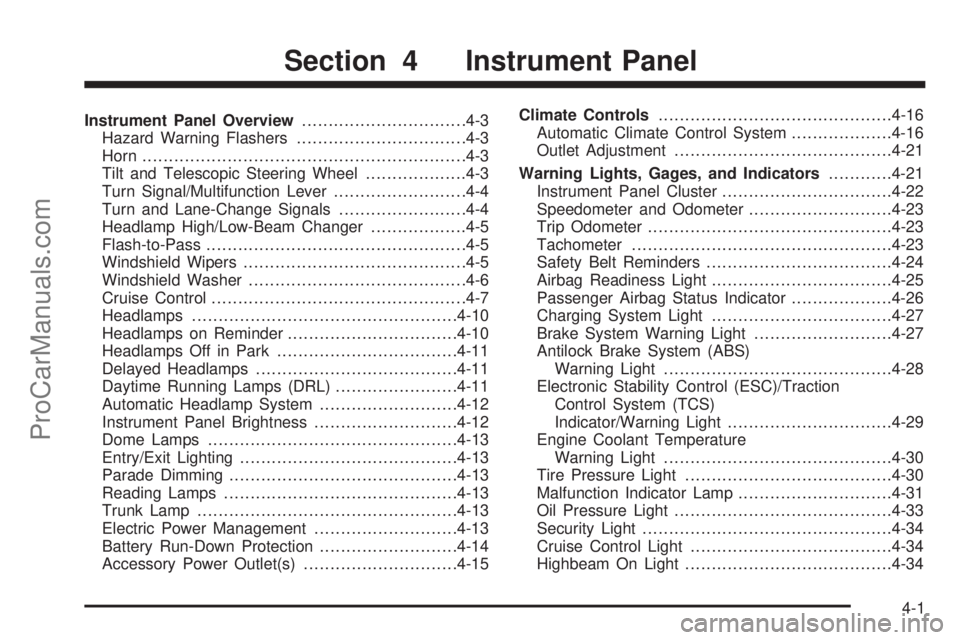
Instrument Panel Overview...............................4-3
Hazard Warning Flashers................................4-3
Horn .............................................................4-3
Tilt and Telescopic Steering Wheel...................4-3
Turn Signal/Multifunction Lever.........................4-4
Turn and Lane-Change Signals........................4-4
Headlamp High/Low-Beam Changer..................4-5
Flash-to-Pass.................................................4-5
Windshield Wipers..........................................4-5
Windshield Washer.........................................4-6
Cruise Control................................................4-7
Headlamps..................................................4-10
Headlamps on Reminder................................4-10
Headlamps Off in Park..................................4-11
Delayed Headlamps......................................4-11
Daytime Running Lamps (DRL).......................4-11
Automatic Headlamp System..........................4-12
Instrument Panel Brightness...........................4-12
Dome Lamps ...............................................4-13
Entry/Exit Lighting.........................................4-13
Parade Dimming...........................................4-13
Reading Lamps............................................4-13
Trunk Lamp.................................................4-13
Electric Power Management...........................4-13
Battery Run-Down Protection..........................4-14
Accessory Power Outlet(s).............................4-15Climate Controls............................................4-16
Automatic Climate Control System...................4-16
Outlet Adjustment.........................................4-21
Warning Lights, Gages, and Indicators............4-21
Instrument Panel Cluster................................4-22
Speedometer and Odometer...........................4-23
Trip Odometer..............................................4-23
Tachometer.................................................4-23
Safety Belt Reminders
...................................4-24
Airbag Readiness Light..................................4-25
Passenger Airbag Status Indicator...................4-26
Charging System Light..................................4-27
Brake System Warning Light..........................4-27
Antilock Brake System (ABS)
Warning Light...........................................4-28
Electronic Stability Control (ESC)/Traction
Control System (TCS)
Indicator/Warning Light...............................4-29
Engine Coolant Temperature
Warning Light...........................................4-30
Tire Pressure Light.......................................4-30
Malfunction Indicator Lamp.............................4-31
Oil Pressure Light.........................................4-33
Security Light...............................................4-34
Cruise Control Light......................................4-34
Highbeam On Light.......................................4-34
Section 4 Instrument Panel
4-1
ProCarManuals.com
Page 153 of 400

Cruise Control
Cruise control lets a speed of about 40 km/h (25 mph)
or more be maintained without keeping your foot on
the accelerator. Cruise control does not work at speeds
below 40 km/h (25 mph).
{WARNING:
Cruise control can be dangerous where you
cannot drive safely at a steady speed. So, do not
use the cruise control on winding roads or in
heavy traffic.
Cruise control can be dangerous on slippery
roads. On such roads, fast changes in tire traction
can cause excessive wheel slip, and you could
lose control. Do not use cruise control on slippery
roads.
Setting Cruise Control
{WARNING:
If you leave your cruise control on when you are
not using cruise, you might hit a button and go
into cruise when you do not want to. You could be
startled and even lose control. Keep the cruise
control switch off until you want to use cruise
control.
The cruise control buttons
are located on the steering
wheel.
4-7
ProCarManuals.com
Page 154 of 400

I(On/Off):Press to turn the cruise control system
on and off.
RES+ (Resume):Press to resume a set speed and to
accelerate the speed.
SET−(Set):Press to set a speed and to decrease
the speed.
To set a speed do the following:
1. Press
Ito turn cruise control on. The indicator
light on the button comes on.
2. Get up to the desired speed.
3. Press the SET−and release it. The cruise symbol
displays in the instrument panel cluster to show the
system is engaged.
4. Take your foot off the accelerator pedal.
When the brakes are applied, the cruise control
shuts off.
If the vehicle is in cruise control and the Traction
Control System (TCS) begins to limit wheel spin, the
cruise control automatically disengages. SeeTraction
Control System (TCS) on page 5-7. When road
conditions allow, the cruise control can be used again.
Resuming a Set Speed
If the cruise control is set at a desired speed and then
the brakes are applied, the cruise control is disengaged.
But it does not need to be reset. The cruise symbol in
the instrument panel cluster also goes out indicating
cruise is no longer engaged. Once the vehicle speed is
40 km/h (25 mph) or more, briefly press the RES+.
The vehicle returns to the previously set speed
and stays there.
Increasing Speed While Using Cruise
Control
There are two ways to increase the vehicle speed while
using cruise control:
•If the cruise control system is already engaged,
press and hold the RES+ button until the desired
speed is reached, then release it.
•To increase the vehicle speed in small amounts,
briefly press the RES+ and then release it. Each
time this is done, the vehicle goes about 1.6 km/h
(1 mph) faster.
4-8
ProCarManuals.com
Page 175 of 400

Electronic Stability Control
(ESC)/Traction Control System
(TCS) Indicator/Warning Light
The Electronic Stability
Control (ESC) system or
the Traction Control
System (TCS)
indicator/warning light
comes on briefly when the
engine is started.
If it does not, have the vehicle serviced by the
dealer/retailer. If the system is working normally the
indicator light goes off.
This light, along with the appropriate Driver Information
Center (DIC) messages, indicates when the ESC
system and the TCS are working or are disabled.If the light comes on and stays on, the TCS and
potentially the ESC system have been disabled. Check
the DIC messaging to determine which system is
turned off, or not working. If the system is not working,
the vehicle needs service. See your dealer/retailer.
When the TCS is disabled, wheel spin is not limited.
When the ESC system is disabled, the system does not
aid in maintaining vehicle directional control.
If the light comes on and flashes, the TCS or the ESC
system is actively working. When the LOW TRACTION
message appears, the system is limiting wheel spin.
When the ESC ACTIVE message appears, the system
is aiding in maintaining vehicle directional control.
SeeElectronic Stability Control (ESC) on page 5-6and
Traction Control System (TCS) on page 5-7for more
information.
SeeDIC Warnings and Messages on page 4-41for
more information on the messages associated with
this light.
4-29
ProCarManuals.com
Page 188 of 400

DOOR AJAR
This message displays if one or more of the vehicle’s
doors are not closed properly. Make sure that the
door(s) are closed completely.
ENGINE DISABLED
This message displays if the starting of the engine is
disabled. Have your vehicle serviced by your
dealer/retailer immediately.
ENG (Engine) PWR (Power) REDUCED
This message displays when the vehicle’s engine power
is reduced. Reduced engine power can affect the
vehicle’s ability to accelerate. If this message is on, but
there is no reduction in performance, proceed to
your destination. The performance may be reduced the
next time the vehicle is driven. The vehicle may be
driven at a reduced speed while this message is on, but
acceleration and speed may be reduced. Anytime this
message stays on, the vehicle should be taken to
your dealer/retailer for service as soon as possible.
ESC (Electronic Stability Control) ACTIVE
If your vehicle has Electronic Stability Control (ESC),
this message displays and the ESC/TCS light on
the instrument panel cluster flashes when ESC is
assisting you with directional control of the vehicle. You
may feel or hear the system working and see this
message displayed in the DIC. Slippery road conditionsmay exist when this message is displayed, so adjust
your driving accordingly. This message may stay on for
a few seconds after ESC stops assisting you with
directional control of the vehicle. This is normal when
the system is operating. SeeElectronic Stability Control
(ESC) on page 5-6andElectronic Stability Control
(ESC)/Traction Control System (TCS) Indicator/Warning
Light on page 4-29for more information.
ESC (Electronic Stability Control) OFF
If your vehicle has Electronic Stability Control (ESC),
this message displays and the ESC/TCS light on
the instrument panel cluster comes on solid when ESC
is turned off. Adjust your driving accordingly. See
Electronic Stability Control (ESC) on page 5-6and
Electronic Stability Control (ESC)/Traction Control
System (TCS) Indicator/Warning Light on page 4-29for
more information.
HOOD AJAR
This message displays if the hood is not fully closed.
Make sure that the hood is closed completely. The
vehicle will not auto stop when the hood is ajar.
ICE POSSIBLE
This message displays when the outside air temperature
is cold enough to create icy road conditions. Adjust
your driving accordingly.
4-42
ProCarManuals.com